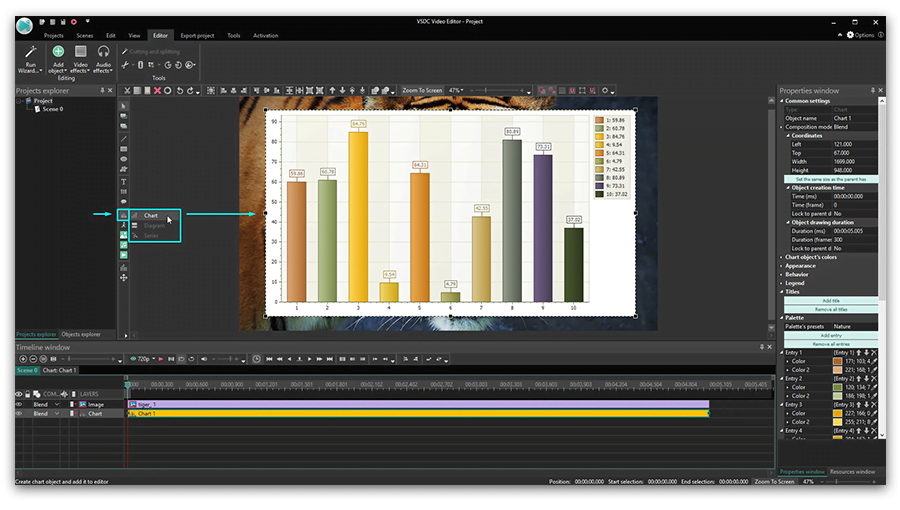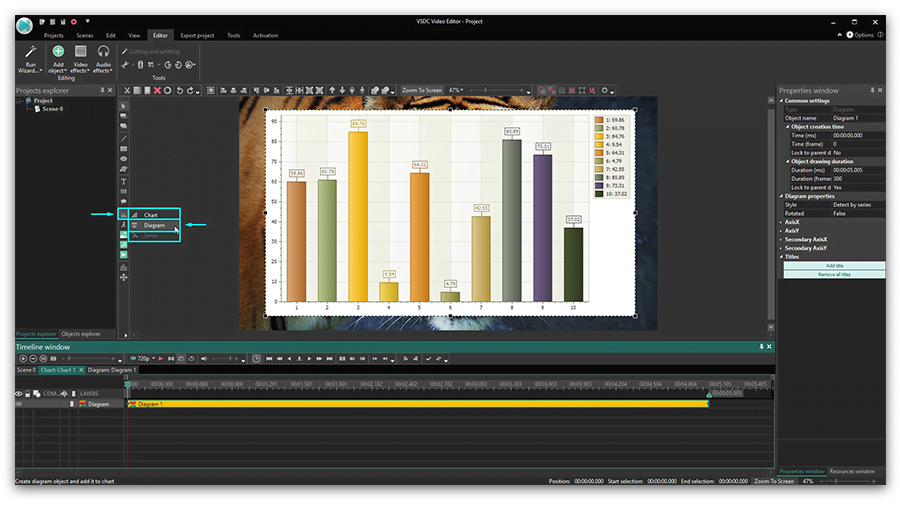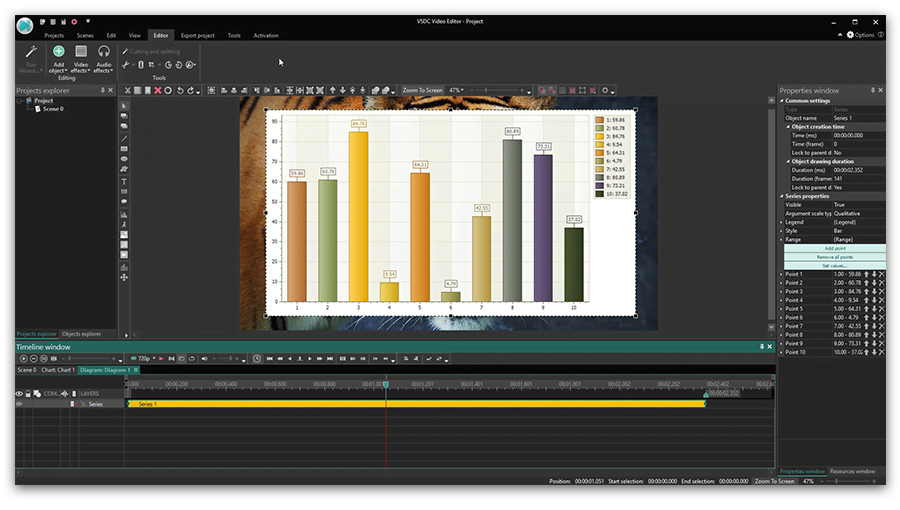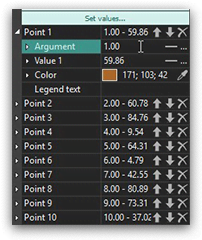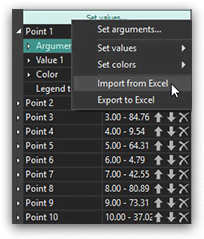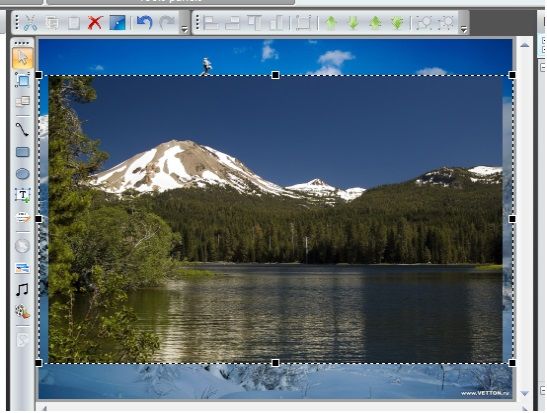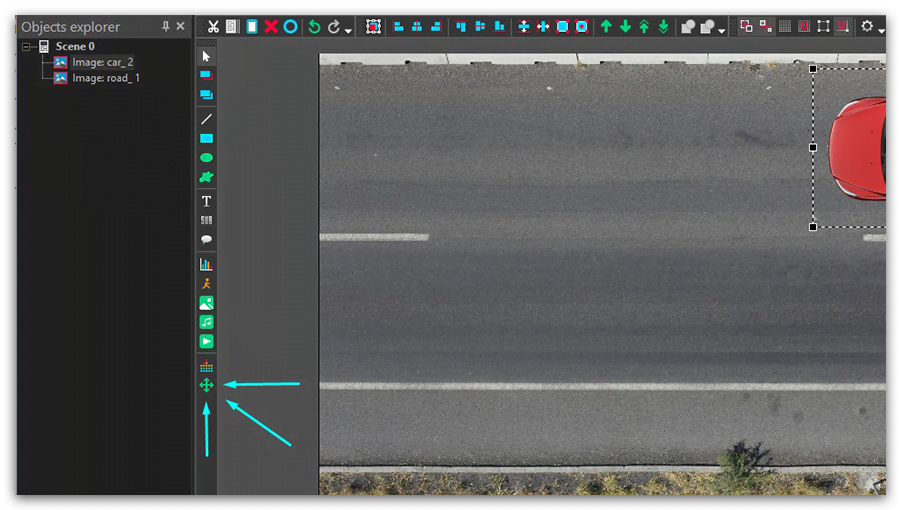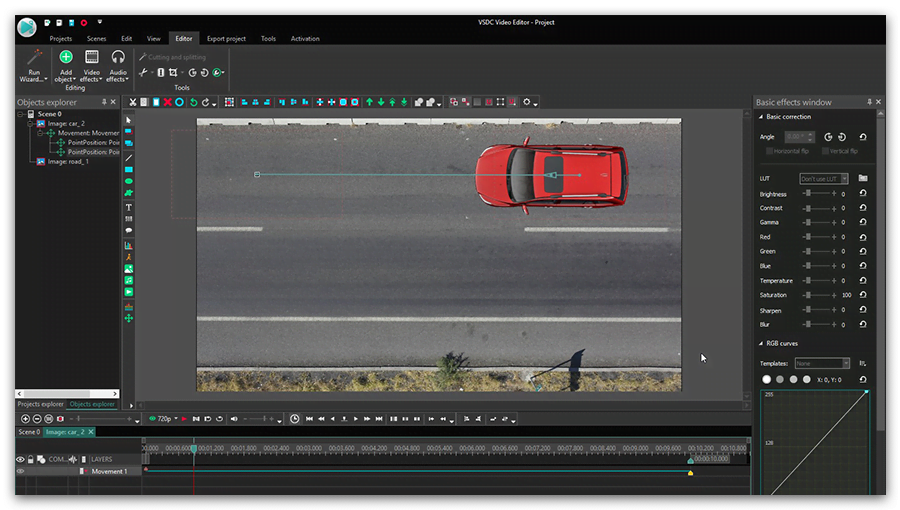Video Editor
Use free video software to create and edit videos of any complexity from a family greeting card to a company presentation. Cut, merge video files, apply visual and audio effects, use filtration and image correction, make slideshows and add an appropriate soundtrack. Use multi-color Chroma Key and advanced parameters settings to give your video a professional look. All popular video and audio formats are supported.
Video Converter
This program is intended for converting video files from one format to another. Nearly all popular video formats are supported (both reading and saving). In addition, the program drastically simplifies the task of converting videos for playback on specific multimedia devices, such as iPhone, Samsung Galaxy or Huawei P30 Pro. The program is extremely easy to use, has a modern interface and all necessary video processing functions.
Audio Converter
The audio converter will help you convert audio files from one format to another. All key audio formats and codecs are supported. The program also allows you to manage playlists and meta tags, extract audio from video files and save these tracks on your computer in any format.
Audio CD Grabber
This audio tool is intended for grabbing audio tracks from compact discs and saving them to the user’s computer in any format. Nearly all popular audio formats and codecs are supported. The program can also extract track details from the FreeDB server for automatic file renaming and updating meta tags.
Video Editor
Video Converter
Audio Converter
Audio CD Grabber

Multifunctionality
A wide array of multimedia processing tools in one free video software suite.

High speed
Our programs use fast
and high-quality algorithms optimized for single and multi-core CPU’s.

Affordability
VSDC video software is freely available for download to Windows OS-based PCs and laptops.
- Welcome to the next level of video editing with VSDC's latest release, Version 9...
- Welcome to the latest VSDC update, Version 8.3! We've been working hard and we’r...
- In today’s digital landscape, the popularity of video content is gaining momentu...
- In today's digital world creativity reigns supreme. It offers endless possibilit...
How to use VSDC Free Video Editor: starting guide
When we talk about VSDC, we like to describe it as a professional-level video editing software. Partly because of the non-linear video editing technique it allows for using, and partly because of its mighty feature-set (have you checked our color correction tools yet? Masking? Animation?).
On the other hand, before you jump into exploring all these fancy video editing tricks, you’ll need to get familiar with the basics. Especially if you’ve never worked with a non-linear video editor before. And that’s exactly what we’ll cover below. We’ll show you how to perform the most essential basic actions in VSDC: cutting, cropping, rotating, and more. So, prepare yourself a large mug of coffee (or whatever helps you stay focused), sit back, and launch VSDC on your PC to practice new skills right away.
By the way, we encourage you to always make sure you’ve installed the latest version of VSDC from our official website. Here is where you can do it.
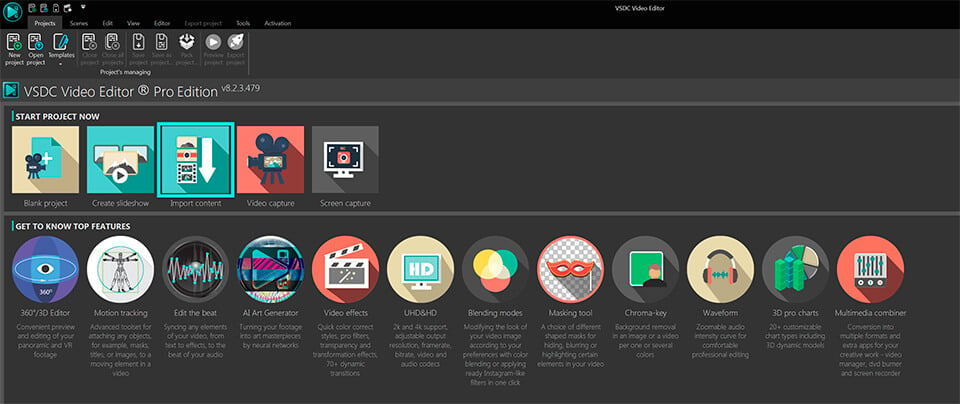
How to import a video to VSDC
There are several ways to import files to VSDC. First, you can use the “Import content” icon on the start screen when you launch the program (illustrated above). This is an optimal way because VSDC will automatically detect all the parameters of your video and adjust the project parameters accordingly. After you choose a file on your PC, a window will pop up asking whether you’d like to change resolution, framerate, or other parameters. Once ready, hit “Finish”.
You can also add files to your project in real-time while working on it. To do it, use the dedicated “Add object” buttons located at the top and on the left-hand side of the program menu - see the illustration below. Note that when you add a new file this way, a window pops up to confirm object’s position settings and layer’s position. The latter allows you to choose whether the file should be added as a new layer or placed on the current one.
If you select “Add a new layer”, the new layer will be added at the very top. The “Insert new layer” option will add one right below the selected layer.
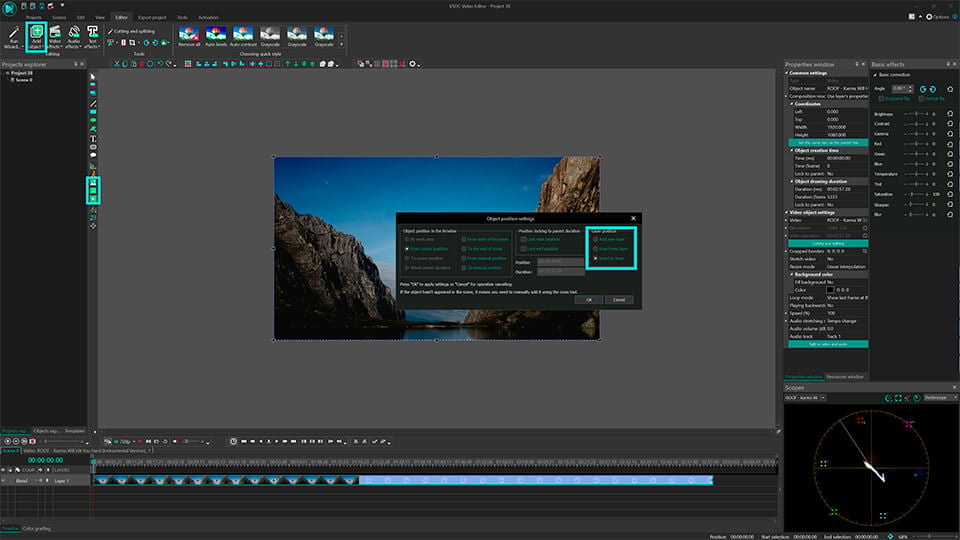
Finally, you can use hotkeys:
- Shift + I – to add an image
- Shift + A – to add an audio file
- Shift +V – to add a video
Each time you select a file on your computer, it’s automatically placed on the timeline. Keep in mind that you can have files on the same layer (linear sequence) or on different layers (non-linear sequence). Still feeling a bit confused? Check out this video tutorial to get a hang of VSDC timeline.
How to cut, split, crop, and rotate a video in VSDC
The reason these features are united in one chapter – they all are available in the same quick-access menu. It’s located at the top of the program interface and called “Cutting and Splitting tools” – see the illustration below.
The first icon is an image of scissors – the cutting tool. It’s especially convenient when you need to trim the beginning of a video or its ending. Place the cursor precisely where you need to make a cut, open the dropdown cutting menu (the little triangle near the scissors icon) and choose “Trim start” or “Trim end”.
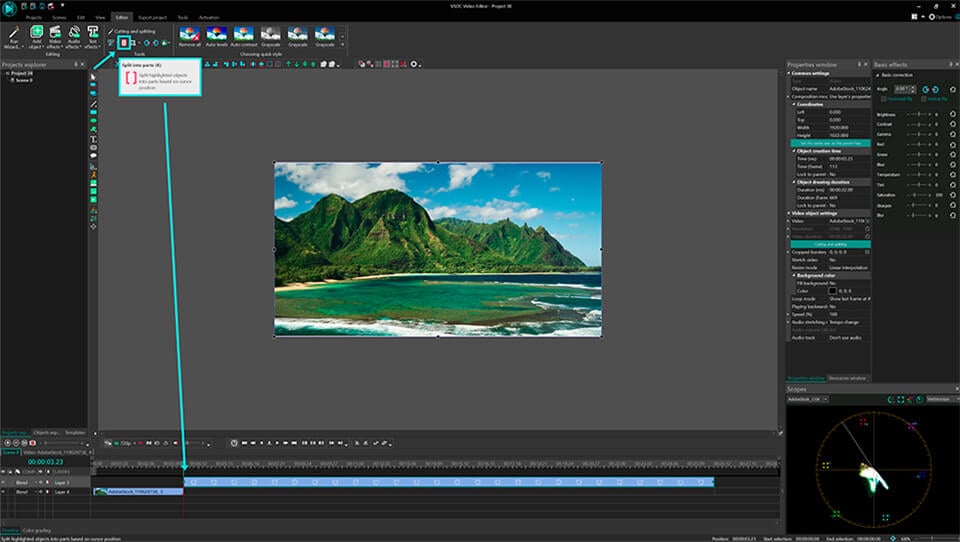
Now, if you need to split a video into parts, use the next icon – the one looking like a razor. Keep in mind, that when you need to delete a fragment, you should first click anywhere on the timeline to remove the selection from the entire file (otherwise you’ll delete the file entirely) and then select the fragment you want to get rid of. A very detailed guide on splitting videos into parts in VSDC is published here.
Cropping is quite easy too. If you have recorded too much extra space around the scene object, just click on the file you need to crop and use the cropping icon from the “Cutting and Splitting” menu. A new window will pop up where you’ll be able to select the area that should remain in the scene. Check out this tutorial on cropping borders of a video if you need further guidance.
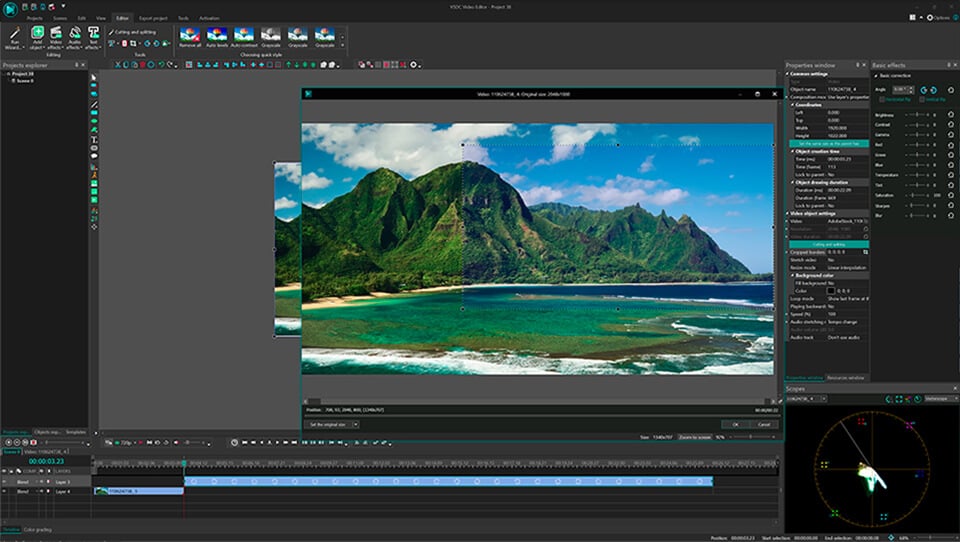
Finally, the quick access menu includes two icons allowing you to rotate your footage 90 degrees clockwise or counterclockwise. This feature is quite intuitive: click on the file you need to rotate and choose the required direction. If your project requires custom angle rotation, check out this detailed instruction.
How to apply effects and transitions in VSDC
VSDC allows for creating dozens of eye-catching video effects. Some of them are applied in one click and require no experience. They are located on the “Video effects” tab at the top ribbon menu and include quick Instagram-style filters, basic color adjustments, transitions, transformational and transparency effects.
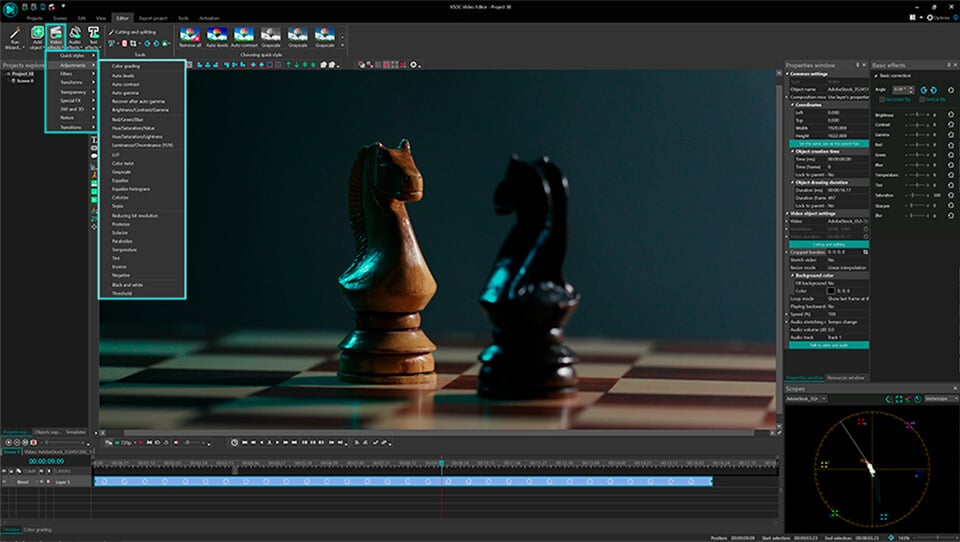
To apply one, select the video file you want to modify, go to the Video effects tab and choose the necessary effect. A new tab will be created on the timeline – it will contain all the effects applied to the selected object. There, you’ll be able to change the effect duration and its position timewise by dragging it with the mouse. Other parameters can be configured in the properties window located on the right-hand side.
The same rule applies to transitions. Place a cursor exactly where the transition should start, select the transition from the Video effects dropdown menu, and adjust its duration manually.
How to mute a video in VSDC
If you need to shut down the sound of a video completely, the easiest way is the following:
- Click on the video file with a right mouse button
- From the menu, select “Properties”
- Go to the Properties window on the right-hand side
- Scroll down and find “Audio track”
- Select “Don’t use audio”
Alternatively, you can use the button “Split to video and audio” (also located on the Properties window) and once the audio track is separated on the timeline, just delete it.
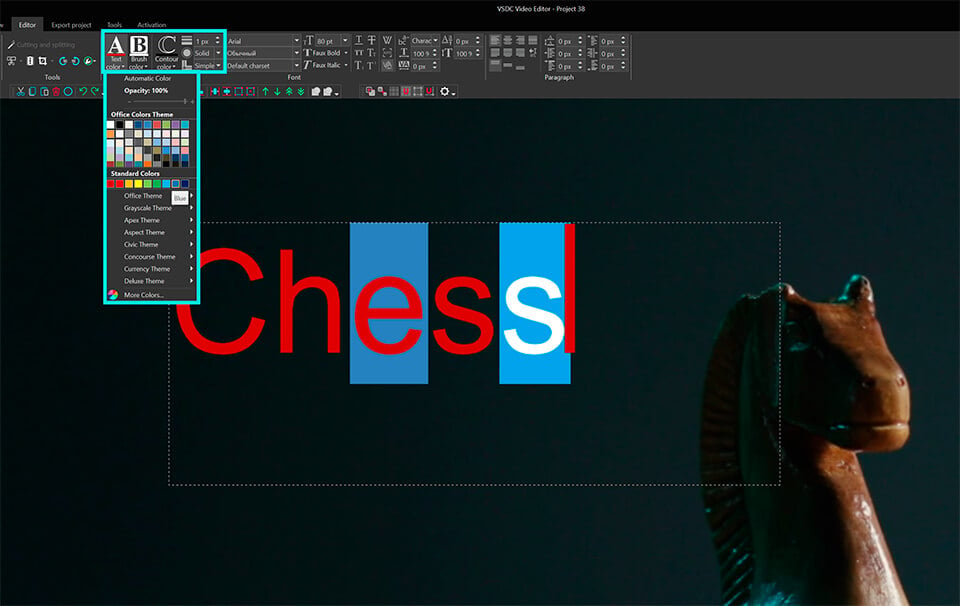
How to add a text to a video or an image in VSDC
VSDC offers a full-featured built-in text editor. It allows you to create beautiful titles and text-related effects. To add a text object in VSDC, go to the left-hand side of the program interface and hit the “T” icon. Select “Text” and place the cursor on the scene to specify title location. Then type your text and adjust its size, style, and color using the upper menu as you would do in a regular text editor.
Again, you can use the dragging motion and the Properties window to change the duration and other parameters of your text object. Here is a very detailed how-to guide on working with text in VSDC.
How to export a video in VSDC
Before exporting your video, make sure everything looks exactly the way you want. Use the red preview button and lower the preview quality if the video appears choppy. Lagging sometimes happens when the resources of the PC aren’t enough to process the video in real-time. Keep in mind, it doesn’t affect the outcome in any way.

Once ready, go to the Export project tab and choose the output format. For your convenience, there are a few pre-configured export profiles available. Their settings are based on how you’re planning to use the video. For instance, if you want to upload it to YouTube, select “Web – For YouTube”. The output file is typically saved in the “C:\Users\Owner\Videos\” folder unless indicated differently. If you’d like to change the location, you can do that by clicking the “Change name” button (located right below the preview window).
Hit the red “Export project” button at the top of the menu and wait until the conversion process is over. If you see a Pro version upgrade popup, and you aren’t ready to upgrade, simply hit the Continue button at the bottom right corner.
Looking forward to learning more about VSDC capabilities?
Check out our How-to section, subscribe to our YouTube channel, and follow our Facebook page for the latest updates, tips and tricks.
You can get more information about the program on Free Video Editor' description page.

This program allows you to capture the video of your desktop and save it on your PC in various formats. Coupled with a video editor, the program is a great tool for creating presentations, tutorials and demo videos.

The program captures video from external devices and records it to computer in a free format. You can save video from video tuners, webcams, capture cards and other gadgets.

"VSDC Free Video Editor is a surprisingly powerful, if unconventional video editor"
- PC Advisor

"This video editor gives you tons of control and editing power"
- CNet

"The editor handles many common formats and boasts a good deal of capabilities when it comes time to alter lighting, splice video, and apply filters and transitions in post production"
- Digital Trends
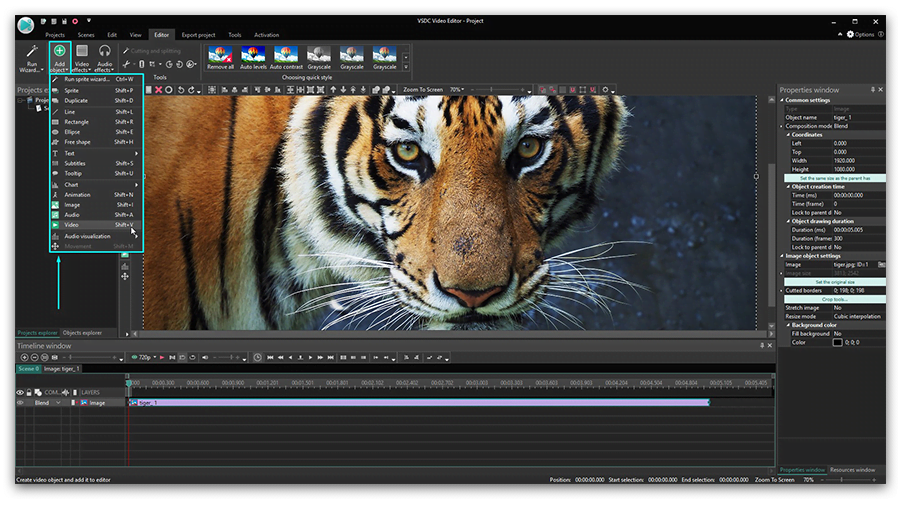
 button on the toolbar. Later you can change the Chart position adjusting the “
button on the toolbar. Later you can change the Chart position adjusting the “